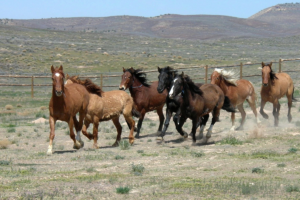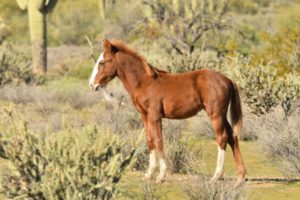It’s early January, and wildlife ecologist Craig Downer is filled with melancholy as he looks out the window of his Minden, Nevada, home at the majestic pine nut mountain range. The U.S. Bureau of Land Management (BLM) has decided to remove 200 wild horses from the Pine Nut Herd Management Area and roundup at least 132 more, before it then releases them back onto the range after 66 mares receive the 22-month Porcine Zone Pellucida (PZP) immunocontraceptive vaccine—a contraceptive that will keep the mares from foaling for two or more years. (The roundup was stopped thanks to Friends of Animals’ efforts.)
“It’s pretty heartbreaking to see that happening, because I grew up here,” said Downer, author of The Wild Horse Conspiracy.
“It’s a tremendous range, very large. But they just want to restrict the wild horses there just to the northern part. That is the first group of wild horses I really got to know as a teenager.” 
Downer’s frustration with the cattle culture of the BLM, which caters to ranchers, is shared by Friends of Animals.PZP is an unnecessary evil— just like roundups—because wild horse populations are too small already to ensure survival for future generations.
The Equid Specialist Group of the International Union for Conservation of Nature’s Species Survival Commission recommends minimum populations of 2,500 individuals for the conservation of genetic diversity. Currently, no single herd management area on public lands has a minimal viable population for the long term. The debate over whether controlling wild horses’ reproductive lives is acceptable has become so heated that it has caused a significant break among wild horse advocates.
It’s time to hold everyone accountable who is pushing risky PZP drugs—made from slaughterhouse pig ovaries. PZP is a ‘restricted-use pesticide’ that has labeled wild horses as ‘pests’ thanks to the Humane Society of the United States, the registrant of the drug. Why did horse advocates join up with BLM? The public will hold all these PZP pushers responsible for the destruction of America’s wild horses on public land.”
Part of the problem is that BLM tries to paint this rosy picture and portray themselves as saviors to the public rather than the backyard breeders with a wild horse extinction plan.
“The widespread use of PZP is really very contrary to the true core intent of the Wild Horse and Burro Act of 1971, which was to restore wild horses as naturally, integrated, harmonious components of the public land ecosystem who are not overly tampered with,” Downer said.
“This is a very invasive thing they are doing to these animals. “Wild horses are just trying to fill their niche. But the BLM is telling them their niche isn’t what it should be because they have to give 90 percent of the forage to the ranchers, even though the law says in the horses’ legal areas the land will ‘be principally devoted to wild horse and burros welfare and benefit.’ The BLM ignores that and continues business as usual.”
It didn’t surprise Friends of Animals that a lot of the research touting the advantages of PZP has been conducted by those with a vested interest in it— the Humane Society of the United States, which has to approve the use of PZP on wild horse herds—and the late Jay Kirkpatrick, who was an HSUS consultant for contraception and director of the Science and Conservation Center in Billings, Montana, which produces the active ingredient in PZP.
In a recent issue of All Animals, HSUS prides itself on helping to implement a humane alternative to roundups with PZP. It describes how it is using a $1.7 million grant from the Annenberg Foundation to try out the longer lasting PZP-22 at Cedar
Mountains and Sand Wash Basin. The trials have been underway since 2008 and results are expected this year.
Downer said PZP pushers are counting on intellectual laziness, hoping that the public will just go along and not inquire. Not if Friends of Animals and its supporters have anything to say about it. FoA will continue uncovering research that reveals adverse effects of PZP— that it sterilizes wild horses after multiple uses and results in risky foal birth out of season and significant behavioral changes that can affect the overall health of the herd. For instance, a 2009 Princeton University study of the horses on Shackleford Banks in North Carolina, who started receiving PZP in 2000, showed that prolonged infertility has significant consequences on social behavior.
“We found that females who were receiving contraception were much more likely to change groups,” said Cassandra Nunez, one of the researchers.
“The way PZP works is mares are still cycling and trying to mate with the male. They don’t know they are contraceptive and so they think there is something wrong with the male and say, ‘I am going to see what the neighbor can do for me.’”
Normally bands are really very stable, says Nunez, and mares will stay with males much if not all of their lives. That stability is really important for the health of the group members. Foal mortality increases when there are a bunch of different changes, and parasite load of animals in the group can go up because they are getting more stressed. The National Park Service (NPS) and the Foundation for Shackleford Horses reached out to Nunez in 2005 after they had received anecdotal reports that the mares seemed “unsettled.”
In a later study in 2010, Nunez found that recipients of PZP also extend the receptive breeding period into what is normally the non-breeding season, resulting in foal birth out of season.
“If mares get pregnant in the winter time, they are going to give birth in the winter time and that’s not a good time because your resources are really low,” Nunez said.
“Normally the winter is spent eating as much as they can, and everyone is more relaxed. Males tend to let females roam farther, which is good because food is patchier. So all of this is changing because of extended cycling.”
Some foals born late had to be removed from Shackleford Banks because they weren’t doing well, said Nunez, adding that in 2009, in response to some of her data, NPS decided to stop its contraception program.

“I think they realized that it was leading down a path they didn’t want to go,” she said, adding that reproductive rates are still quite low at Shackleford Banks.
“It’s taking a while for the contracepted mares to respond physiologically,” Nunez said.
“We showed NPS that even when you stop treating a mare, she doesn’t give birth right away. Years later she is still not producing. So that flexibility that you think you have with PZP…it’s not really that flexible.”
PZP will never replace roundups because in most cases the BLM will have to gather more than 90 percent of a herd to contracept mares, destroying the harem structure in the same way a regular roundup would. Knowing what they know, it’s maddening to anti-PZP wild horse advocates that the BLM is investing $2.8 million into researching contraception methods, money Downer says would be better spent on implementing reserve design, a holistic way to manage wild horses.
Reserve design would let wild horses reoccupy their full legal herd areas as outlined in the WHBA, which were stolen from them by ranchers, and involves utilizing natural and/ or artificial barriers, natural predators, as well as community-involving buffer zones. Once available habitat is filled, the horse/burro, as a climax species, limit their own population as density-dependent controls are triggered.
“We just have to persist in this even though there are no guarantees,” Downer said. “It’s like the war between good and evil. We are not defeated as long as we still know right from wrong and still have the will to fight what’s wrong.”
